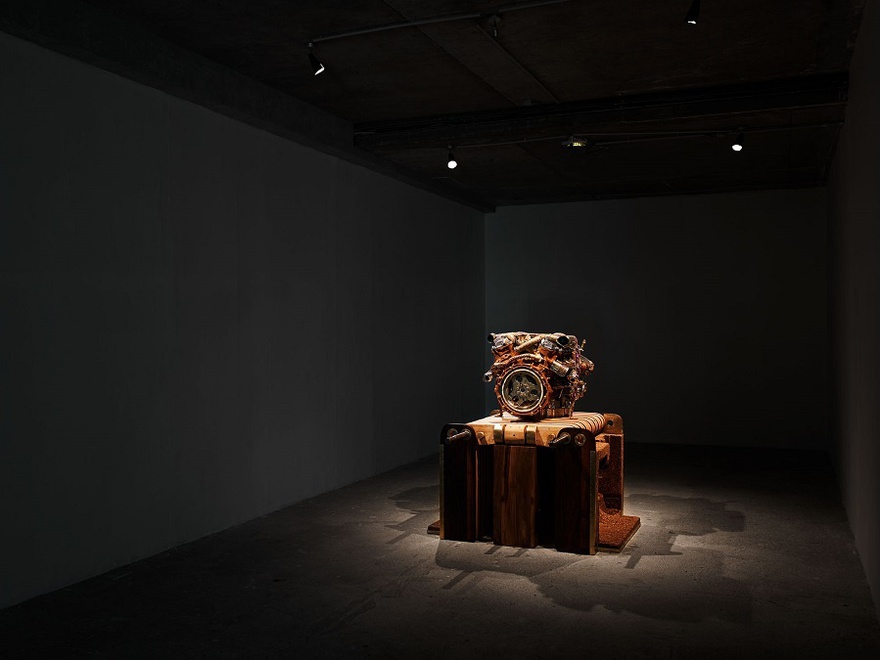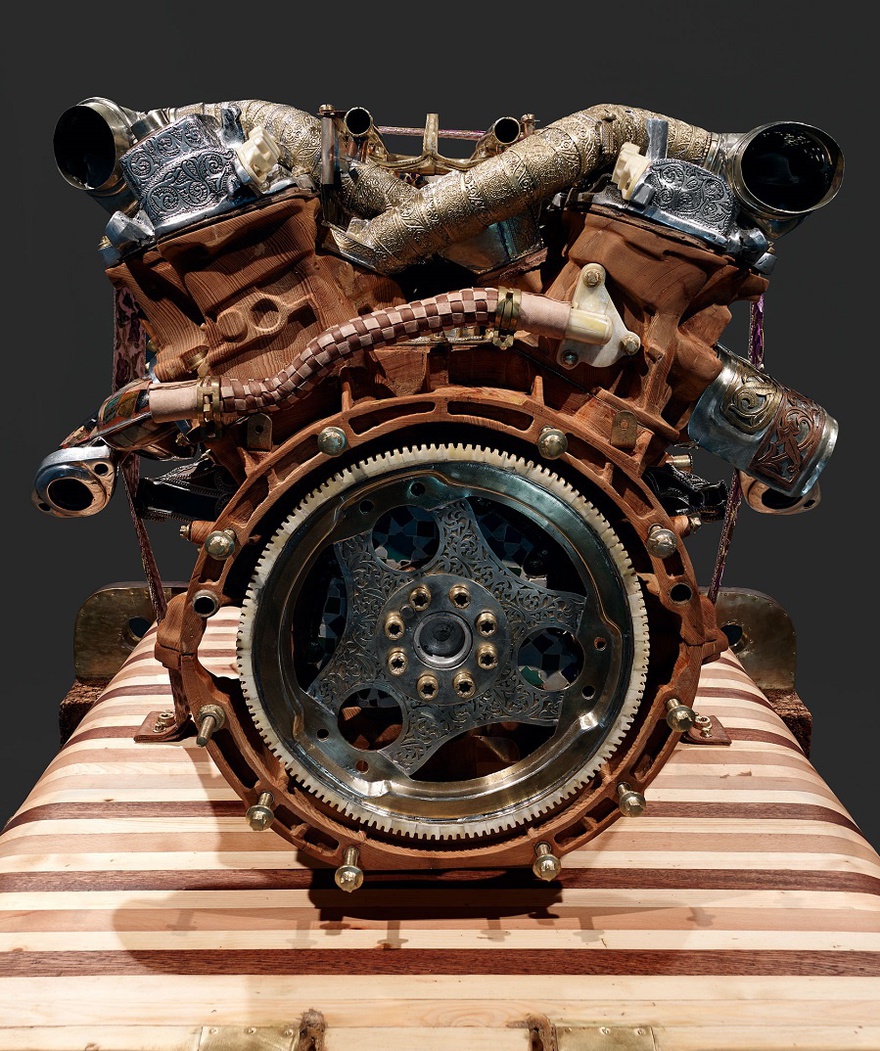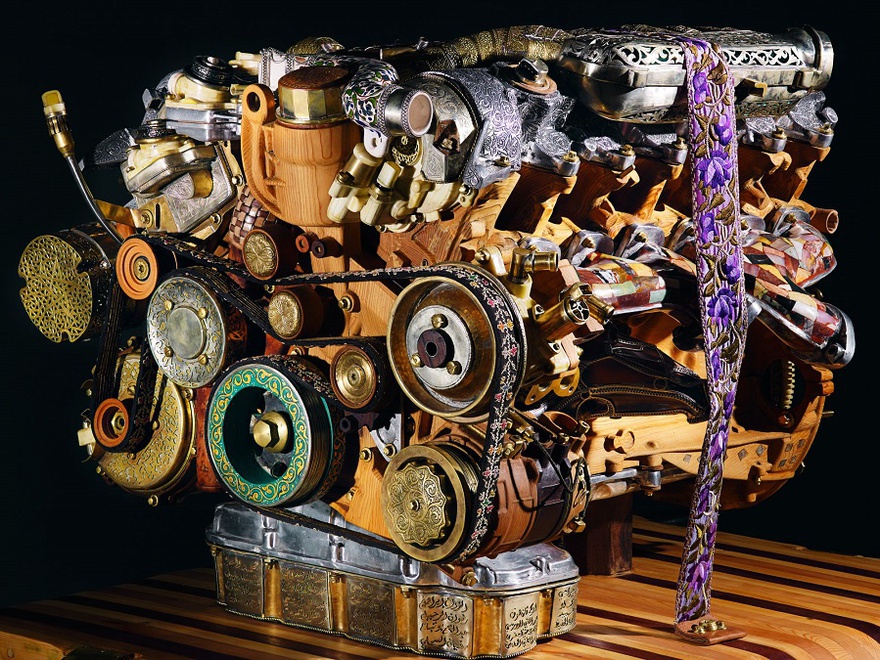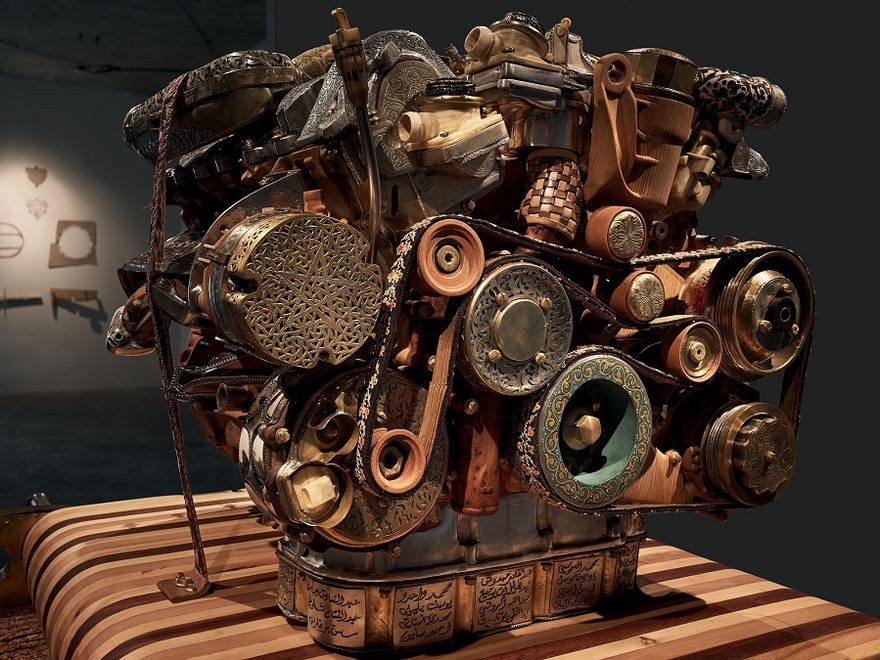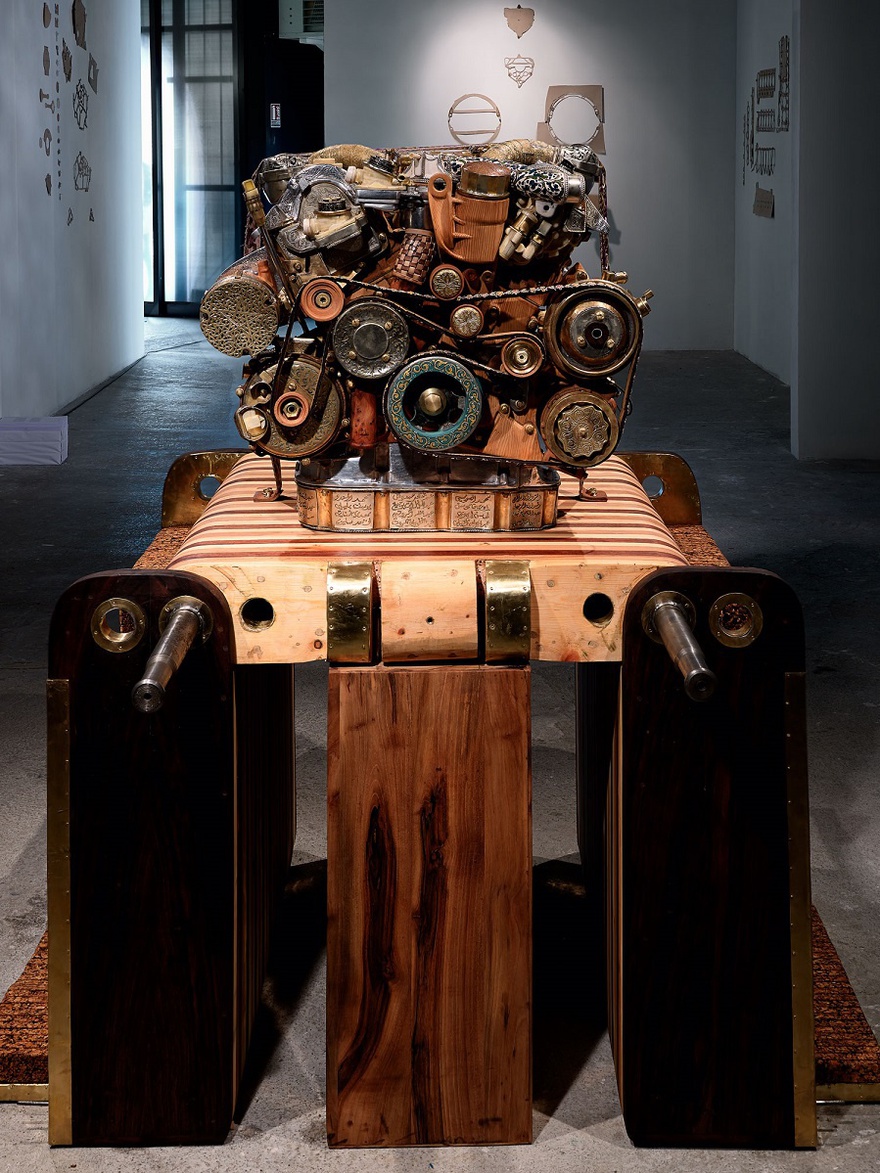Interviews
A Big Bang Theory
Eric Van Hove in conversation with Natasha Hoare
Eric Van Hove's work V12 Laraki (2013), recently exhibited at STUK Leuven and L'Institute du Monde Arabe, Paris, is the summation of 9 months of production and many years of conceptual gestation. This socio-economic sculpture is an exact replica of the Mercedes-Benz V12 engine, used in the abortive first-ever Moroccan sports car, and the product of thousands of hours of labour by Moroccan craftsmen whom Van Hove sought out from across diverse quarters of Marrakech, Morocco. Each worked to recreate 465 pieces of the engine in 53 different hand crafts, exceeding the original Laraki vision and Mercedes' technological exactitude to bring into being a work that speaks of time, the value of labour, cross cultural exchange, and a deeply Moroccan aesthetic. Ongoing relationships with many of his collaborators has shaped the very fabric of Van Hove's atelier outside Marrakech in the Ourika Valley, many of those who worked on the V12 project are now fully employed at the studio creating evermore ambitious works based around engine parts.
Natasha Hoare: As a nomadic artist – a Belgian national born in Algeria – you seem to have situated yourself within a specific nexus of the Global South. What prompted this?
Eric Van Hove: It is true. I have wandered quite a lot in the past 15 years, and a lot of that has been in the Global South. What I learned at art school in Europe, after returning from Africa at the age of 12, was a medium of expression that is very filtered through western standards. If art is universal, contemporary art is a western medium – pretty much an institution – and the way of it is conceptualism. I was taught to use this approach: it is my craft somehow. I just don't feel bound to using it only there, in Europe. You can't easily go to the centre of Africa with conceptual art and apply it there: there is a vocabulary to invent. Like humour, it can only exist when you are surrounded by the right semio-cultural set up. I wanted to try and see how cosmopolitan that contemporary art language was, because I felt that conceptual crafting of ideas and concepts in a poetic way was a very beautiful medium. I wanted to see how it could meet with other locations. So the point was not to make an artwork outside to be brought back for consideration by a westernized audience, like so many artists have done and still do, but to use that medium to make contemporary works on the outside, for the outside.
I think simply that I saw all these young artists from Africa and Asia struggle to find their balance, to express themselves with an original voice, making a huge translational effort to fit into a western sense of art. Let me use a metaphor: if the Chinese had invented programming we would now need to learn to programme software in Chinese characters – imagine any western programmer having to learn Chinese first before starting to code...well it's the same in art today. Young artists have to fit an international idea of what contemporary art is, what is mediatized or talked about. It has very intangible semiotics as well, based on delicate things, so if you are not from that mainstream culture it's incredibly perverse. It's a challenge to express certain cultural ideas with a different language from that cultural sphere – what is kitsch and what is not, for instance.
NH: Why did you think it was important to move away from those cosmopolitan centres such as Brussels to take your practice elsewhere?
EVH: I felt like a visitor in Europe. I ended up doing contemporary art as it felt like the only thing that wasn't about inscribing yourself in the system. It felt neutral, even if the medium is a western one. I wanted to work towards the outside audience in an inversion of what was being required of outside artists towards Europe. So I made 'Arab Art', 'African Art' and so on. When I brought these back to Europe curators would most often not get the context. Of course, if you make a relevant context-specific work in, for example Madagascar, then there is a lot to get acquainted with before you can enjoy the artwork. I was basically asking from curators and viewers in Europe what is implicitly required from all Global South artists…and of course they wouldn't bother.
I would use the conceptual medium to reflect and work locally in a cultural sphere that was not European. Sometimes aspects of it were very confusing. This Eurocentric perspective, as a European, is very hard to recognize. But it is not just about Europeans: if you were an Arab you might have a tendency to think everything is towards you and your view: it's about power. Western modernity is so strong that most intangible view points are established there, and those are fundamental in art.
NH: You've mentioned previously that you came across instances of conceptualism within cultures that you visited during your travels through China.
EVH: Manipulation of ideas or concepts is nothing new. When I was working outside of my cultural sphere I did make site-specific works on occasion, but I insisted on the fact that my work was context-specific. That is a much broader term than 'site': it encompasses the intangible.
NH: I wanted to discuss your recent major work, V12 Laraki. The work is a perfect copy of a Mercedes-Benz 6.2L V12 engine, each of its 465 components handcrafted in 53 materials traditional to Morocco through the craftsmanship of 42 artisans. Does the engine owe anything to your living in Asia?
EVH: Indeed, I studied Japanese classical calligraphy under Master Hideaki Nagano in Tokyo for five years. Again, I just wanted to learn a language that had nothing to do with Indo-European heritage, and an art form foreign to it, too. After securing a PhD in Tokyo in 2008, I remember feeling amused when I realized that the Japanese had given me a Masters in calligraphy education but would never allow for a foreigner to teach their kids anything in that field…so I was aiming at adding a string to my bow and widen my scope which it did, but I wondered if I would ever put this knowledge to use in my work as a contemporary artist, since I never considered myself a calligrapher.
But while working on this engine in Morocco years later, I suddenly felt I was using every bit of the knowledge Mr Nagano had given me. As much spiritually as philosophically, the engine owes a lot to my years of living in Japan and studying Japanese traditions, considering for example that copying is one of the main axioms of calligraphy apprenticeship, an endeavour that lasts for a lifetime, too. Asian calligraphers – and that is something that can be found all around Asia and connects to their deeper beliefs – copy thousands of times over old Chinese classical parchments. Copying, which in the western world is considered an artificial loss of time, is in Japan the essence of creativity – while western ideas of progress tend to believe that creating new things is possible if not a requirement, the Japanese duplicate the past as a contemporary creative end. V12 Laraki is no different: the Mercedes-Benz engine was copied bit by bit, faithfully. I 'invented' nothing, but I 'contemporized' it in the fashion of a calligrapher.
NH: In 2012 you moved to Marrakech to take up a residency and begin work on the V12 Laraki project. Since that time you have remained in the region, founding your atelier in the Ourika valley. What took you to Marrakech specifically?
EVH: The fact that it's the most diverse place for craft in the world that I have come across, though maybe Indonesia is similar. If I needed to make something with a diversity of media, heritage and materials, this was the right place.
NH: Your atelier in Marrakech is named after the funduqs; Maghrebi gathering places for traders and their animals. How is the atelier structured and how has it developed?
EVH: The Fenduq came after the engine. The engine was really developed in the boot of my car, because the craftsmen were then working in their own workshops wherever they were, and they could only all be gathered together in one place when they had enough trust in the project and me. So at first it was about me going to them. I had to drive maybe a 130,000 kilometres across the country to connect all these people and pieces.
The Fenduq is my atelier, a context-specific production facility that makes sense. What we described before is exactly what is at stake there. How many exhibitions did you see last year that had a non-western title? In the globalized art scene everything happens in English, or to go even further, everything happens in the Global North's semiotics. Curators increasingly try to make exhibitions based on concepts that are non-western. It is difficult somehow, it shows how ossified the situation is. You can hardly use an Iranian title (that is untranslatable, indeed, because it is interesting) for an international show for it's all contextualized within the godhead of European culture, and the Global North audience just isn't used to even trying to do what all the actors in the Global South are doing daily. I think I'm staying with that now, calling it a Fenduq, and the first show I will do at STUK will be called Atchilihtallah, which is of course a concept nobody will understand at once, and will take some explaining, but I want to do more of these things. Atchilihtallah loosely translates as 'this is what God gave us.'
Now that the Fenduq is established, it works for me like a living sculpture: a socioeconomic sculpture of sorts. I say that because when you bring many human beings into a creative process there is a lot you don't control anymore. These people start to influence you, it's a dialogue, and you can't avoid being transformed by this process. Somehow, I never had a clear image of what the engine would look like until it was in front of us.
NH: Is the development of the atelier part of your practice?
EVH: Sure, why not. It's a context-specific living sculpture in constant movement. When you start with a title and then you have a structure, it's difficult to avoid missing the point, to remain free and unbounded, to discover different ways of doing things. As I mentioned earlier I did a PhD in Japan, one of these doctorates for artists – a thing western modernity is used to. I had to produce a thesis as an artist, and as you know the way of producing a thesis is very much codified through westernized academia. So I decided not to make a thesis in the western, pyramidal structure in which you prove the thesis wrong or right, because this form says there is something correct and incorrect; it supposes that there is a truth to find. In Japanese culture, there is no such thing as truth. They are animists, so the opposition between good and evil is different. There is not just a dichotomy because things are much more fluid: there is a bit of each in everything. So I structured my thesis after the School of Kyoto's principles, which, after the Americans brutally occupied Japan in 1945, was the last school of thought in the country that was relevant. They thought that you had to take the Japanese and western ways of doing things and harmonize them. Through achieving equilibrium between these two forces you would approach a truth. It's a beautiful model.
There is something of that in my practice and in the atelier. Here, the model is inspired by the way the craftsmen work, there is a specific socioeconomic model in the way that they earn money, the way materials can be found. That structure is born from a certain way of doing things here and I try to let it go, to not know in advance where it is going. As the conductor initiating it, I unify the performers, set the tempo, execute clear preparations and beats, and shape the sound of the ensemble, but we work collectively somehow and each of these craftsmen is unique and influences what is happening. So, for instance, now I want to work on a running electric motorbike out of these craft materials. The craftsmen are all waiting for the next big project.
NH: What was that moment like of showing the engine in Marrakech at the Biennale this year?
EVH: I was very lucky to be able to show a piece like that in the city that fathered it. Many artists do projects that are then shown elsewhere. I think that there is a whole underlying context that doesn't have to be explained to Marrakechis, they really get it – it's using their language, it's this effort of translation. It's the ultimate human effort to translate our existence, our ideas on why we are here, on the existence of God. So here we translate an object of German design into Moroccan craft. And it's the same story of material and the familiarity people have with this material in the Moroccan context.
NH: What was so telling about that moment was the Moroccan audience went straight up to the engine to touch it, whilst western audiences stood at a respectful distance. There is a relationship in Morocco to the hand, to craft, to touch, which isn't present in Europe, I think.
EVH: The nature of an object is core to the industrial era and what it meant to us all. A magic object and what it can represent can become a totem. We tell stories through these items and represent the whole world through them. A talisman is just a stone but becomes so much more. Here I am interested in blurring these things. I have this project where the idea was to bring the engine to the Great Mosque in Casablanca, and to try and get the Imam there to host the engine within the sanctuary of the mosque, to sacralize it, to allow it to be charged and to give its charge away, to blur the context of the secular and the sacred. For most of us here there is an aspect in the engine that is sacred.
100 years of industrialization made sure that our relationship to the items surrounding us is broken: we see them as dead vessels, and not stories. This is something that interests me in sculpture, the unseen intangible part of the material you are using. So now I am trying to cosmopolitanize craft by starting to bring into contact within the same sculpture materials and techniques that are unrelated, in the hope that magic could occur. A Big Bang.
V12 Laraki is on show as part of exhibitions at STUK, Leuven 25 September – 18 November and the Institut de Arabe du Monde, Paris 15 October – 25 January 2015. A book documenting its creation, Eric van Hove – V12 Laraki, was released by Motto publishing in September 2014 and presented alongside his solo exhibition at Copperfield in London. For more information, follow this link: http://www.copperfieldgallery.com/eric-van-hove-v12.html.
Eric van Hove (b. Algeria, 1975) is a Cameroon-raised Belgian conceptual artist. His work is pluridisciplinary and includes wanderlust, defamiliarization, psychogeography and dérive, though he has recently started to mostly work with sculpture. In 2012 he moved to Morocco to start creating V12 Laraki (2013). He subsequently founded an atelier in Marrakesh where he presently lives and works.

